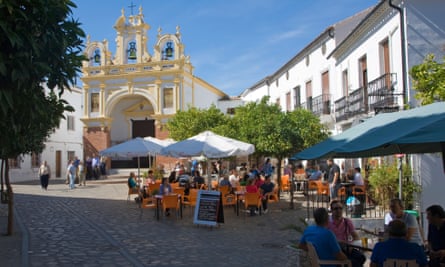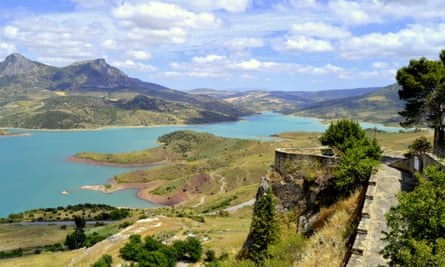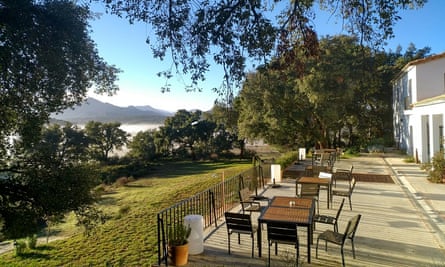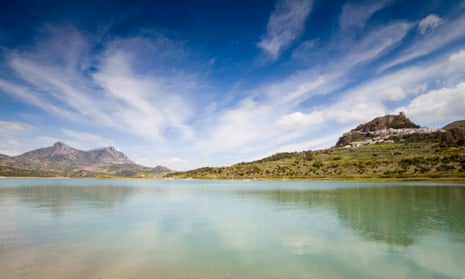A goat farmer told me no one swims in the lake at Zahara de la Sierra because it’s full of fish with crocodile heads. Is that why I’m the only person in 128 sq km of cool water on a very hot day? I later learn that this manmade lake (embalse), the mountain ranges to the south of it, and the cliffs, gorges, flower meadows, forests and caves all around are simply, for the most part, empty. Spain has a surplus of staggeringly beautiful wild spaces, but this one – almost 54,000 hectares north-east of Cadiz, overflowing into the province of Málaga – became the country’s first Unesco biosphere reserve in 1977. And Sierra de Grazalema became Andalucía’s first parque natural in 1984.
Most foreign visitors, myself included, discover the park by accident while driving from Ronda to Seville, do a double take on spotting the lake and the fairytale village of Zahara, wrapped around its crag like a wonky wedding cake, slam on the brakes, make a detour, and end up staying – sometimes for a lifetime.
I check into a casa rural at an old olive mill on the edge of a village called Molino el Vinculo, eat jamón and goat’s cheese at a local bar, imagine living here and, next morning, wake to the sound of cockerels, wood pigeons … and puffing.

The heavy breathing comes from three runners and two cyclists heading up the mountain, a 600-metre climb over 11km of buttressed switchbacks to Puerta de las Palomas pass at 1,189 metres. I follow (by car, with burning clutch), heading for Grazalema village, 30 minutes to the south. I pause at the top of the pass to survey the park laid out below: verdant valleys, limestone pinnacles, pinsapo (Spanish fir) forests, more mountains. As I slam the car door, a stag jolts away down the scree.
Grazalema is overshadowed by some serious peaks, most notably Peñon Grande. This is hiking country: many of the park’s 20 official trails start here, and most go upwards. Clearly it’s a weekend playground for Lycra-clad sporty Spaniards – the cafes in Plaza de España are packed with dogs, kids, bikes and people doing stretches.
Following a map from the tourist office, I head up the one-hour Llanos del Endrinal trail, but inadvertently stray on to a longer loop, and wander puzzled through the boulder-strewn plains of Puerto de las Presillas for some time. The climb is amply rewarded by a stretch of cool pine forest, and an hour lying flat on a slab of rock, encircled by lofty peaks where ibex edge along ledges. Below me is a lush flower-filled valley, and above me are swirls of choughs.

To British ears, one of the park’s claims to fame may explain its lack of visitors: it’s one of Spain’s wettest places. The rain falls mainly in winter, though. It also has Europe’s largest colony of griffon vultures, with a nesting site in a deep gorge just outside Zahara, the Garganta Verde.
The trail to the base of the gorge is one of four where access is restricted. Even with one of the 15 permits a day issued by the park office in my backpack, I can’t believe I’m allowed here alone. It’s like a Spielberg film set after the crew has knocked off. As hefty vultures waft across the void, I hear their wings flap. Aside from that, the soft tack and clatter of a rock fall and bursts of bell-clear birdsong, the primeval gorge is eerily quiet. I slide down boulders at the bottom and, edging into the mouth of the Cueva de la Ermita, cautiously examine the underworld.
If I was into caving, canyoning, and spelunking I’d be in luck: the park is made of porous limestone, and an underground world of interconnected tunnels and pools lies beneath. (Actually, it’s the place for exhilarating physical stuff in general: a major centre for paragliding, rock climbing, extreme triathlons, and serious riding.) But the caves are also of historical interest. In Cueva de la Pileta in the eastern section of the park, just above Benaoján and below Montejaque, a lantern-lit tour reveals stalagmites, stalactites and paintings of fish, goats and stick men, some dating back 25,000 years.

Despite a smattering of walking tours and coach parties, Sierra de Grazalema feels pretty unknown. Yet it has been inhabited for a very long time. It is littered with signs of occupation, from megalithic tombs to Roman murals, necropolises and roads – the calzada romana to Ubrique, further to the south, is one of the most popular hikes in the park. The villages themselves, settled by Berbers, conquered by Christians (some invaded by Napoleonic forces), are built on layers of civilisations.
Back in Zahara, the bars under the orange trees are well-patronised: neighbours catching up after an hour apart; older men in berets and shades drinking Pedro Ximénez; teenagers on their phones, sharing tapas; small boys with firecrackers; a table of touring cyclists studying maps. There’s a group of older women up by the cemetery, gazing out over the lake.

Ironically, the jewel of this natural park is a dam, built just over 20 years ago – some villagers still call it the pantano, or swamp. But things are changing, slowly. Younger villagers decamp to the grassy lawns and icy waters of La Playita recreation area by the lakeshore south of Zahara on summer days. On the north shore, a young local couple, Javier and Maria, run El Mogote, a chic cafe and nautical centre with kayaks to rent and the world’s best view. Something similar further south may just open next summer. Or not. For now though, as I stand at the water’s edge, it feels pleasantly wild. Croc-headed fish or no, I jump in.
Permits from Sierra de Grazalema natural park Visitor Centre, El Bosque, juntadeandalucia.es
Where to stay

In Zahara de la Sierra, Al Lago Hotel Restaurant has doubles from €115 B&B (al-lago.es). All areas of the park are accessible from Zahara, but other good bases include: in Benaoján, Molino del Santo (doubles from €115 B&B, molinodelsanto.com); in Villaluenga del Rosario, the traditional Hostal La Posada, (doubles from €60 B&B, tugasa.com); 5km from Grazalema, Tambor del Llano (doubles from around €70 B&B, tambordelllano.es) offers rooms in a wild estate setting. One of very few campsites – with cabins – is Tajo Rodillo in Grazalema (campingtajorodillo.com).

Comments (…)
Sign in or create your Guardian account to join the discussion